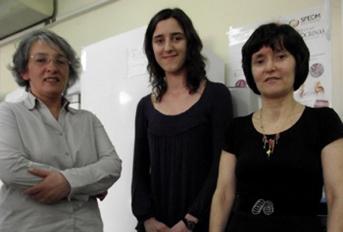Associação Portuguesa de Investigação em Cancro
Mutações nos tumores da tiróide de indivíduos irradiados na infância por tinea capitis
Mutações nos tumores da tiróide de indivíduos irradiados na infância por tinea capitis

Na década de 50-60 foi usada a epilação do couro cabeludo através do uso de raios X para o tratamento da tinea capitis (tinha). O estudo destes indivíduos mostrou um aumento da frequência de tumores na zona da cabeça e pescoço, nomeadamente de tumores da tiróide. Tendo tido acesso a uma cohorte tratada desta forma no norte de Portugal, foi realizada uma pesquisa das mutações mais frequentes dos tumores da tiróide (BRAF, NRAS e o rearranjo cromossómico RET/PTC), num grupo de indivíduos desta cohorte que desenvolveram esses tumores. Os resultados mostraram que a frequência da mutação BRAFV600E nos carcinomas papilares da tiróide é das mais elevadas já descritas em tumores de tiróide de indivíduos irradiados.
Autores e afiliações:
Paula Boaventura1, Dina Pereira1, Ricardo Celestino1, Adélia Mendes1, Tadao Nakasawa1,2, José Teixeira-Gomes1, Manuel Sobrinho-Simões1,3,4, Paula Soares1,3,
1 - IPATIMUP - Institute of Molecular Pathology and Immunology of the University of Porto, Portugal
2 - Department of Pathology, Interdisciplinary Graduate School of Medicine and Engineering, University of Yamanashi, Yamanashi, Japan
3 - Department of Pathology and Oncology, Medical Faculty, University of Porto, Portugal
4 – Department of Pathology, Hospital Centre of S. João, Porto, Portugal
Abstract:
Objective - Exposure to ionizing radiation at young age is the strongest risk factor for the occurrence of papillary thyroid carcinoma (PTC). RET/PTC rearrangements are the most frequent genetic alterations associated with radiation-induced PTC, whereas BRAF and RAS mutations and PAX8-PPARG rearrangement have been associated with sporadic PTC. We decided to search for such genetic alterations in PTCs of patients subjected in the childhood to scalp irradiation.
Design - We studied 67 thyroid tumours from 49 individuals irradiated in childhood for tinea capitis scalp epilation: 36 malignant (12 cases of conventional PTC – cPTC, 2 cPTC metastases, 20 cases of follicular variant PTC – FVPTC, one oncocytic variant of PTC and one follicular carcinoma) and 31 follicular adenomas (FTA).
Methods - The lesions were screened for the BRAFV600E and NRAS mutations and for RET/PTC and PAX8-PPARG rearrangements.
Results – BRAFV600E mutation was detected in 7 out of 14 (50%) cPTC and 2 out of 20 FVPTC (10%) (p=0.019). NRAS mutation was present in one case of FVPTC (5%). RET/PTC1 rearrangement was found, by RT-PCR, in one out of 17 cases (5.9%) and by FISH in 2 out of 6 cases (33%). PAX8-PPARG rearrangement was not detected in any carcinoma. None of the follicular adenomas presented any of the aforementioned genetic alterations.
Conclusions – The prevalence of BRAFV600E mutation in our series is the highest reported in series of PTCs arising in radiation exposed individuals. The prevalence of RET/PTC1 rearrangement fits with the values recently described in a similar setting.
Revista:
European Journal of Endocrinology
Link:
http://eje-online.org/content/early/2013/08/21/EJE-13-0543.abstract




